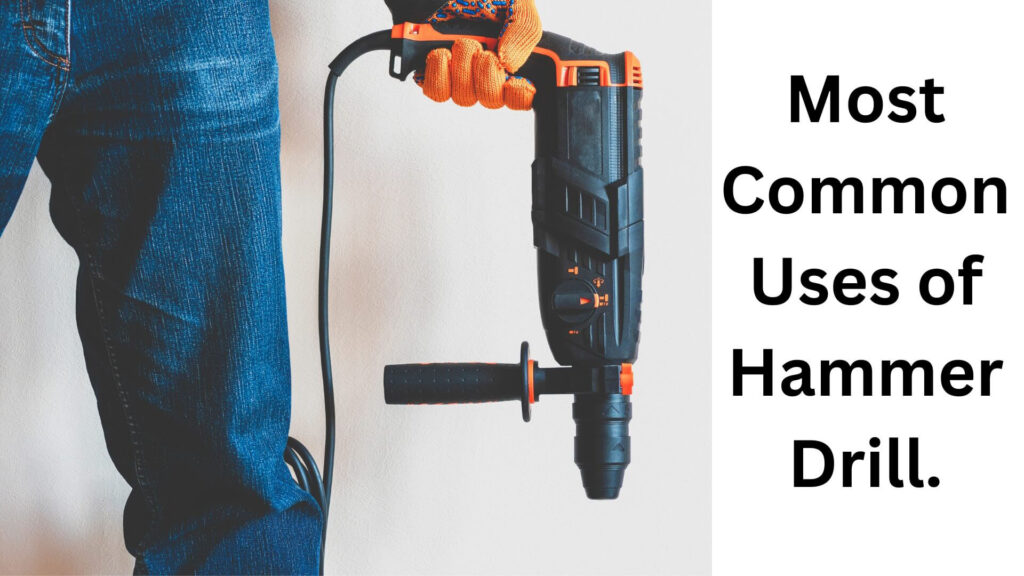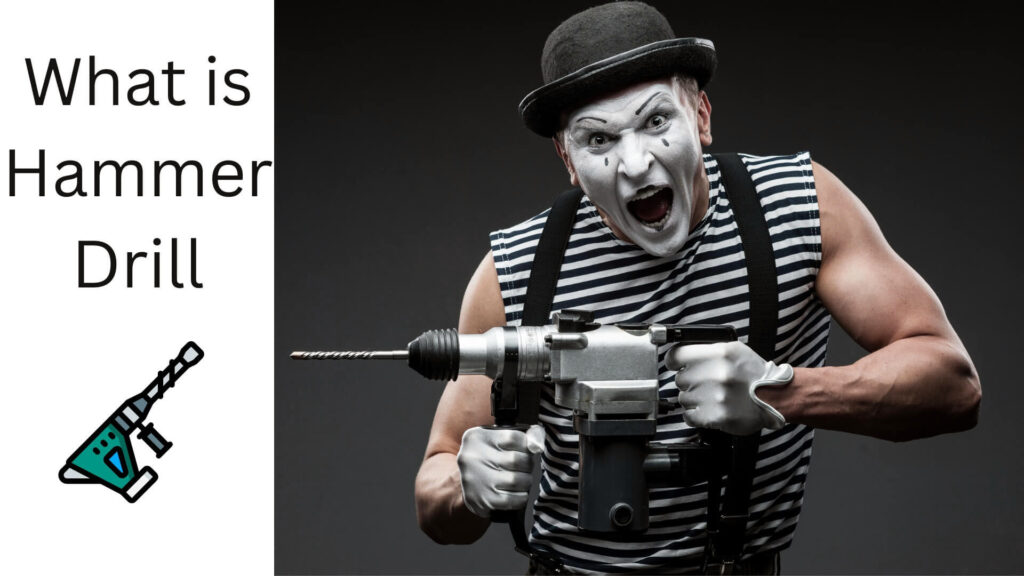Hammer drills are specialized tools that combine the functions of a standard drill with a hammering mechanism, allowing them to efficiently bore holes in hard materials like concrete, masonry, and stone. Unlike regular drills, hammer drills deliver a rapid pounding motion alongside the rotational movement of the drill bit.
This unique feature makes them indispensable for construction, renovation, and various DIY projects where tough surfaces are involved. In this blog post, we will delve into the specifics of hammer drills, their uses, types, and the advantages they offer compared to regular drills.
Table of Contents
What is a hammer drill used for?
Hammer drills are primarily designed for drilling into hard materials. Their unique mechanism enables them to exert additional force to break through tough surfaces. Here are some specific uses:
- Drilling in Hard Materials: The primary function of a hammer drill is to drill holes in concrete, brick, and stone, making it essential for construction and renovation projects.
- Anchor Installation: When securing heavy objects, hammer drills create the necessary holes for anchors, ensuring a sturdy hold in tough surfaces.
- Plumbing and Electrical Work: These drills are invaluable for creating holes in walls for plumbing pipes or electrical wires, allowing for smooth installation without damaging the structure.
Read More: A Guide to Selecting the Right Situations for a Hammer Drill
What are the types of hammer drills?
Hammer drills come in several types, each suited for specific applications. Understanding the differences can help you choose the right one for your needs:
1. Standard Hammer Drill
The most common type, standard hammer drills, combines rotational force with a hammering action. They are suitable for various materials, including concrete, wood, and metal. These drills are often used by DIY enthusiasts and professionals alike.
2. Rotary Hammer Drill
Rotary hammer drills are more powerful than standard hammer drills. They use a piston mechanism to deliver a strong hammering action, making them ideal for heavy-duty applications, such as drilling large holes in concrete or brick. These drills often come with multiple modes for drilling, chiseling, and demolition tasks.
3. Combination Hammer Drill
A combination hammer drill offers the functionality of both a standard hammer drill and a rotary hammer. This versatility allows users to switch between drilling and hammering modes, making it suitable for various tasks.
4. Cordless Hammer Drill
Cordless hammer drills offer the advantage of portability and convenience. Powered by rechargeable batteries, they are ideal for use in areas without easy access to power outlets. Although they may not match the power of corded models, advancements in battery technology have improved their performance significantly.
Check Also: The 7 Best Corded Hammer Drill For Your Home Improvement!
How do I Use a Hammer Drill?
Using a hammer drill effectively requires proper technique and understanding of the tool. Here’s a step-by-step guide to help you:
Step 1: Choose the Right Drill Bit
Select a drill bit suitable for the material you are working with. For masonry and concrete, use masonry bits with a carbide tip. These bits are designed to withstand the hammering action and drilling into tough surfaces.
Step 2: Prepare the Work Area
Ensure the area is clean and free from debris. Mark the spot where you plan to drill with a pencil or chalk to guide your placement.
Step 3: Set the Hammer Drill
Adjust the settings on your hammer drill based on the material and size of the hole you need to create. Many hammer drills offer variable speed and torque settings; selecting the appropriate combination is crucial for optimal performance.
Step 4: Secure the Workpiece
If you are drilling into a movable surface, secure it with clamps or a vice to prevent it from shifting during drilling.
Step 5: Start Drilling
- Position the drill bit on the marked spot.
- Hold the drill firmly with both hands for better control.
- Start at a slow speed to establish the hole, then gradually increase the speed as the bit penetrates the material.
- Apply steady, moderate pressure—allow the drill to do the work rather than forcing it.
Step 6: Clear Debris
Periodically pull the drill bit out to clear any debris from the hole. This prevents buildup, which can hinder the drilling process.
Step 7: Complete the Hole
Once you’ve reached the desired depth, slowly withdraw the drill while continuing to run it. This helps remove any remaining dust or debris.
Step 8: Finish Up
Remove the drill bit and clean the work area. If you’re installing anchors or screws, insert them into the newly drilled hole according to your project requirements.
Read More: What is SDS Drill?
10 of the most common uses for a hammer drill.
Using a hammer drill effectively requires proper technique and understanding of the tool. Here’s a step-by-step guide to help you:
Step 1: Choose the Right Drill Bit
Select a drill bit suitable for the material you are working with. For masonry and concrete, use masonry bits with a carbide tip. These bits are designed to withstand the hammering action and drilling into tough surfaces.
Step 2: Prepare the Work Area
Ensure the area is clean and free from debris. Mark the spot where you plan to drill with a pencil or chalk to guide your placement.
Step 3: Set the Hammer Drill
Adjust the settings on your hammer drill based on the material and size of the hole you need to create. Many hammer drills offer variable speed and torque settings; selecting the appropriate combination is crucial for optimal performance.
Step 4: Secure the Workpiece
If you are drilling into a movable surface, secure it with clamps or a vice to prevent it from shifting during drilling.
Step 5: Start Drilling
- Position the drill bit on the marked spot.
- Hold the drill firmly with both hands for better control.
- Start at a slow speed to establish the hole, then gradually increase the speed as the bit penetrates the material.
- Apply steady, moderate pressure—allow the drill to do the work rather than forcing it.
Step 6: Clear Debris
Periodically pull the drill bit out to clear any debris from the hole. This prevents buildup, which can hinder the drilling process.
Step 7: Complete the Hole
Once you’ve reached the desired depth, slowly withdraw the drill while continuing to run it. This helps remove any remaining dust or debris.
Step 8: Finish Up
Remove the drill bit and clean the work area. If you’re installing anchors or screws, insert them into the newly drilled hole according to your project requirements.

1: Driving screws into wood or metal plate
Hammer drills can be effective for driving screws, particularly when working with tougher materials. Switching to the driving mode allows for quick fastening of screws into wood or metal.
2: Drilling holes in wood or metal
While hammer drills are primarily designed for hard materials, they can also be used for drilling holes in wood and metal. This versatility is a significant advantage for many users.
3: Rotating objects using hand-operated drills
Hammer drills can assist in rotating objects with hand-operated drills. By attaching appropriate bits, you can utilize the drill’s power for various applications.
4: Driving concrete nails into wood
Hammer drills are great for driving concrete nails into wood, making them useful in construction and framing projects where securing materials is necessary.
5: Drilling through brick walls
One of the most notable advantages of hammer drills is their ability to drill through brick walls. This feature is essential for plumbing, electrical work, or installing fixtures.
6: Driving tacks into wood
Hammer drills can be used to drive tacks into wood, which is helpful in various crafts and carpentry tasks.
Read More: How Does a Hammer Drill Work
7: Breaking up frozen ice with a hammer drill
In cold climates, hammer drills can be used to break up frozen ice on surfaces, making them practical tools for outdoor maintenance during winter months.
8: Pounding stakes into the ground
For landscaping or construction projects, hammer drills can help pound stakes into the ground, providing a more efficient method than manual methods.
9: Cutting and trimming branches with a hammer drill
Using a hammer drill with a suitable attachment, you can cut and trim branches, offering an alternative to traditional saws.
10: Making trails with a hammer drill
For outdoor enthusiasts, hammer drills can be employed to make trails in the wilderness by drilling holes for marking paths or securing posts.
Read More: Best Corded Drill under $100 You Should Consider!
What bits do you use with a hammer drill?

Using the right drill bit is essential for effective drilling with a hammer drill. Here are some commonly used bits:
Chiseling Bits: Used for chiseling and breaking concrete or masonry, these bits are ideal for demolition tasks.
Masonry Bits: Designed for drilling into hard surfaces like concrete and brick. They usually have a carbide tip to withstand the impact of hammering.
Carbide-Tipped Bits: These bits are durable and can be used for drilling through various materials, including wood, metal, and masonry.
Spade Bits: Ideal for drilling larger holes in wood, spade bits can be used when less precision is required.
Read More: Using a Hammer Drills Right Way.
What is the advantage of a hammer?

The hammering action of a hammer drill offers several advantages over standard drills:
Reduced Strain: The hammering action helps break through tough surfaces, reducing the strain on the user compared to manual drilling methods.
Increased Efficiency: The hammering motion allows the drill to penetrate hard materials more quickly and efficiently than standard rotary drills.
Versatility: Hammer drills can handle a variety of tasks, from drilling holes to driving screws, making them multifunctional tools.
Check Also: Best Budget Hammer Drill | Top 9 Best with Reviews and Comparison
What is a hammer drill vs. a regular drill?
The main difference between a hammer drill and a regular drill lies in their mechanisms:
Regular Drill: Only provides rotational motion, making it suitable for softer materials like wood and plastic but less effective for tough surfaces.
Hammer Drill: Incorporates a hammering action along with rotational motion, making it ideal for drilling into hard materials like concrete and brick.
Check Also: Homeowner’s Guide To The Best Drill For Concrete Walls!
Do you need a hammer drill to drill concrete?
While it is possible to drill concrete with a regular drill using the right bit, a hammer drill is highly recommended for the task. The hammering action of a hammer drill makes the process much easier and more efficient, allowing for faster penetration into hard surfaces without damaging the drill bit.
Read More: Can a Hammer Drill Break Concrete?
When Should I Replace My Hammer Drill?
Consider replacing your hammer drill if you notice:
Frequent Repairs: If you find yourself frequently repairing your hammer drill, it may be more cost-effective to invest in a new one.
Decreased Performance: If your drill struggles to penetrate materials or overheats frequently, it may be time for a replacement.
Physical Damage: Visible signs of wear, such as a damaged chuck or motor, can indicate that the drill needs to be replaced.
Read More: Can a Hammer Drill Be Used As a Regular Drill?
Frequently Asked Questions.
How fast can a hammer drill?
Hammer drills typically have adjustable speed settings, allowing users to control the RPM based on the material being drilled. Most hammer drills operate between 0 to 3,000 RPM, with a hammering rate of 30,000 to 50,000 blows per minute.
What should I look for in a hammer drill?
When selecting a hammer drill, consider the following features:
Chuck Size: Consider the chuck size that accommodates the drill bits you need for your projects.
Power: Look for a drill with adequate amps or voltage for your intended use.
Speed Settings: Adjustable speed settings allow for versatility across different materials.
Weight and Comfort: Choose a drill that is comfortable to hold and not too heavy, especially for extended use.
How long will it take to finish a job with a hammer drill?
The time it takes to complete a job with a hammer drill depends on the material and the size of the hole. However, due to their efficiency, hammer drills can significantly reduce drilling time compared to manual methods.
What is the best hammer for carpentry?
For carpentry, a hammer drill is typically sufficient for driving screws and drilling holes. However, a framing hammer is the best option for driving nails into wood, providing more force and control.
What is the difference between a hammer drill and a reciprocating saw?
A hammer drill is designed for drilling holes, primarily in hard materials, while a reciprocating saw is used for cutting through various materials, including wood, metal, and plastic. Each tool has its specific application and should be chosen based on the project requirements.
What is the difference between a spade drill and a hammer drill?
A spade drill is designed for drilling large holes in wood and is not equipped with a hammering mechanism. In contrast, a hammer drill combines rotational and hammering actions, making it suitable for drilling into hard materials.
Conclusion
A hammer drill is a powerful and versatile tool essential for anyone involved in construction, renovation, or DIY projects. Its ability to efficiently drill through hard materials, coupled with various features and attachments, makes it an invaluable addition to any toolkit.
By understanding its functions, types, and best practices for use, you can maximize the benefits of this tool and tackle a wide range of tasks with ease. Whether you’re driving screws, drilling into concrete, or performing heavy-duty applications, a hammer drill is designed to help you get the job done efficiently and effectively.

Hey, I am MD Hrithik Hossain, I’m a huge fan of DIY crafts. My workshop is where I spend most of my spare time, and I’m always working on some project. To that end, I’d like to share some of my knowledge and experience with you in power tools, woodworking, and other specialized materials fabrication.
I will guide you with genuine knowledge that can assist you with deciding whether a drill is appropriate according to your requirements or not. If you want to find the best drill and know which type of drill is most suited for your needs, then I can guide you with my expertise. My passion lies in helping others find the correct products they need at an affordable price.


